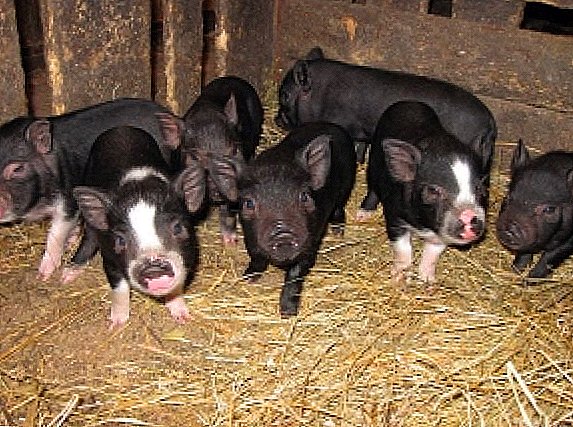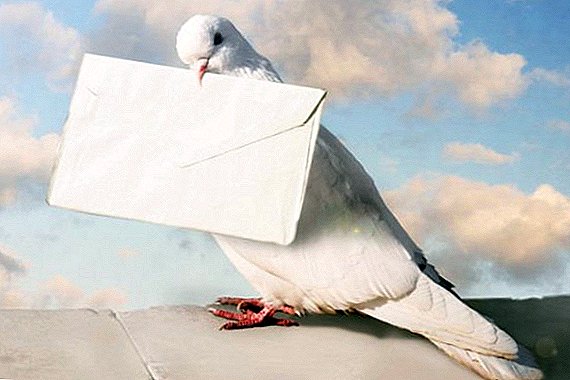 In the view of most modern people, pigeon mail is an anachronism, an echo of the distant past, covered with the aura of romance.
In the view of most modern people, pigeon mail is an anachronism, an echo of the distant past, covered with the aura of romance.
And yet, relatively recently, such a connection was the most common means of communication, and the fastest.
When did the pigeon mail
It is believed that the man tamed the pigeon more than 50 centuries ago, and according to some information, it turns out that this bird has lived with us for about 10 thousand years. For such a long time, residents of different countries were able to see the unusual and very valuable quality of such birds - the ability to accurately find their home.  If we turn to mythology, the first pigeon should be considered, apparently, that Noah sent during the Great Flood in search of sushi.
If we turn to mythology, the first pigeon should be considered, apparently, that Noah sent during the Great Flood in search of sushi.
Important! In terms of speed at long distances, only a swallow, a hawk and a mountain killer whale can argue with a dove-postman. Dove can fly for a long time at a speed of 100 km / h and more.
How do they know where to fly and how far they fly
There are several assumptions regarding how the bird finds its way home. Perhaps as a navigation system, pigeons use natural magnetic fields of the planetor maybe it’s all about the sun, on which position they are oriented in space.
There is no doubt that pigeons can only fly home, that is, to the place from where they took him. Often there were cases when birds flew over a distance of more than 1000 km.
Pigeon mail history
There is reason to believe that pigeon mail appeared and became popular even before the beginning of ancient times. As soon as the small tribes scattered across the boundless expanses replaced the states, the need arose to quickly and accurately transfer messages between the capital and the provinces.  Great importance was communication in military affairs. And since the signal fires or drums transmitted a signal only for a short distance, they could not compete with fast and hardy birds.
Great importance was communication in military affairs. And since the signal fires or drums transmitted a signal only for a short distance, they could not compete with fast and hardy birds.
It is interesting to read about the origin and history of the domestication of chickens.
Antiquity and the Middle Ages
The ability of pigeons to return to their nest was known in Ancient Greece, Rome, Egypt and the Middle East. In the early Middle Ages, the Gauls and German tribes not only used doves as civilian postmen, but also actively used their skills for military purposes and in trade.
 In the middle of the XII century Egypt was one of the centers of development of this type of communication.
In the middle of the XII century Egypt was one of the centers of development of this type of communication.
The reason for this was the unprecedented generosity of the local nobility, who agreed to pay huge money for well-trained postmen.
Later, in the 70s of the XVI century, during the Eighty Years War, pigeons played a significant role in the siege of the rebellious Dutch city of Leiden by the Spaniards. When the inhabitants of the besieged city, in despair, were ready to surrender, the leader of the Dutch army, William of Orange, sent them a message with the help of a pigeon, in which he urged the townspeople to hold on for three more months. In the end, Leiden was never captured.
Did you know? The Belgian Pigeon Sports Society, organized in 1818, should be considered the first club for postal pigeon lovers. Then likee clubs began to open across Europe. After 100 years in Paris alone, there were 8,000 trained feathered postmen.
Nineteenth century
Before the advent and widespread use of the telegraph, there were only two types of relatively fast communications: the equestrian messenger and the carrier pigeons. Moreover, the latest deliveries of messages were significantly ahead of the first ones.  Friedrich von Amerling (1803-1887) “Pigeon Mail” Even in the age of the industrial revolution, feathered postmen were often simply irreplaceable. To some extent, thanks to them, future financial empires were built - the ancestors of modern transnational corporations.
Friedrich von Amerling (1803-1887) “Pigeon Mail” Even in the age of the industrial revolution, feathered postmen were often simply irreplaceable. To some extent, thanks to them, future financial empires were built - the ancestors of modern transnational corporations.
An example of this is the deal that brought Nathan Rothschild huge profits: in 1815, thanks to the feathered mail, this businessman learned of the defeat of Napoleon at Waterloo two days earlier than his competitors.  Nathan Rothschild Naturally, the economic consequences of a military defeat were instantly calculated by the genius of commerce.
Nathan Rothschild Naturally, the economic consequences of a military defeat were instantly calculated by the genius of commerce.
Knowing how this news will affect French securities in a couple of days, he performed the necessary operations on the exchange, and as a result was one of the main, if not the only beneficiary (beneficiary).
Around the same time, the government of the Netherlands established the pigeon post system, used both for civilian purposes and for the needs of the army, on the islands of one of its colonies - the modern Indonesia. As a means of delivery used breed of Baghdad pigeons.
Important! You should not train an unpaired bird; it can find a mate for itself elsewhere. For the same reason, it is not necessary to release separated birds from the pigeon house.
During Franco-Prussian War of 1870-1871, the only means of communication with the besieged by the Germans Paris was feathered postmen. The amount of information is simply amazing - 150 thousand of official documents only, and almost seven times more private messages.  By that time, this type of communication had not bypassed technical progress: the messages were compiled, for more transmitted information, with the help of photo-magnification techniques. Accordingly, the photographic enlarger was used to decipher dispatch.
By that time, this type of communication had not bypassed technical progress: the messages were compiled, for more transmitted information, with the help of photo-magnification techniques. Accordingly, the photographic enlarger was used to decipher dispatch.
The main terminal from where mail was sent to Paris was the city of Tours; pigeons from the French capital were taken on the air balloon. The Germans tried to fight the air mailmen with the help of hawks, but the lines of communication still operated.  Perhaps the siege of Paris, and perhaps something else was the reason that at the end of the XIX century, many European countries started postal pigeon services for military needs.
Perhaps the siege of Paris, and perhaps something else was the reason that at the end of the XIX century, many European countries started postal pigeon services for military needs.  But not only the military actively used the talent of birds - the newsmen did not leave him without attention either. For example, the most popular at that time various regattas were actively covered in the press. People wanted to know about the results of swims as early as possible. Accordingly, the newspaper, which earlier provided reliable information about the results of races, sold more copies than competitors. It was then that the newsmen began to negotiate with the owners and captains of the yachts, so that they would take on board the delivery vehicles of urgent dispatches - pigeons.
But not only the military actively used the talent of birds - the newsmen did not leave him without attention either. For example, the most popular at that time various regattas were actively covered in the press. People wanted to know about the results of swims as early as possible. Accordingly, the newspaper, which earlier provided reliable information about the results of races, sold more copies than competitors. It was then that the newsmen began to negotiate with the owners and captains of the yachts, so that they would take on board the delivery vehicles of urgent dispatches - pigeons.
Check out pigeon breeding tips, and read about pigeon lifespan.
At the end of the XIX century Hawaii have not yet been one of the US states and a respectable resort. It was a small group of islands lost in the Pacific Ocean, which was rarely visited by a postal or passenger ship - and even more often for the replenishment of water or fruit. 3 years before the beginning of the twentieth century, not just a postal service was organized on the archipelago, but a prototype of modern companies - money translators: in addition to letters, this service sent cash.
It is worth mentioning also about Great Barrier Island Postal Service.  From the end of the 19th century until 1908, when a telegraph cable was laid along the ocean floor, it connected the island with the capital of New Zealand - Auckland.
From the end of the 19th century until 1908, when a telegraph cable was laid along the ocean floor, it connected the island with the capital of New Zealand - Auckland.  Institution was called Service bluegram. This institution was distinguished by a very solid, professional approach: it even issued its postage stamps.
Institution was called Service bluegram. This institution was distinguished by a very solid, professional approach: it even issued its postage stamps.  The Service had a record-breaker and its record holder - the Velocity pigeon, which overcame more than 100 km in 50 minutes.
The Service had a record-breaker and its record holder - the Velocity pigeon, which overcame more than 100 km in 50 minutes.
Did you know? Prince of Prussia Frederick Karl gave his mother a pigeon brought from Paris. After 4 years the bird broke free, managing to find "the road" and go back home.
First and Second World Wars
The twentieth century, despite all its technological breakthroughs, did not forget about pigeons: they continued to be widely used during the First and Second World Wars.  British war pigeon, World War I. These birds saved lives of soldiers and sailors more than once, delivering reports in situations where no one except them was able to do so. In addition to saving lives, birds helped to achieve victory in seemingly hopeless situations.
British war pigeon, World War I. These birds saved lives of soldiers and sailors more than once, delivering reports in situations where no one except them was able to do so. In addition to saving lives, birds helped to achieve victory in seemingly hopeless situations.  French soldiers with pigeons, 1914-1915 You can recall the famous story Viti Cherevichkinathat every Soviet schoolboy knew. A fifteen-year-old teenager was shot by the Nazis because, contrary to German orders, he did not destroy his pigeons, using them to communicate with the Red Army in captured Rostov.
French soldiers with pigeons, 1914-1915 You can recall the famous story Viti Cherevichkinathat every Soviet schoolboy knew. A fifteen-year-old teenager was shot by the Nazis because, contrary to German orders, he did not destroy his pigeons, using them to communicate with the Red Army in captured Rostov.  Monument Vite Cherevichkina
Monument Vite Cherevichkina
Do they use them today?
After the war, the famous Reuters news agency used avian postmen to deliver news dispatches because of traffic jams that prevented the car from passing. In Yalta, the local newspaper Kurortnaya Gazeta also used this type of communication.
Currently, pigeon mail is used only occasionally - for advertising, commercial purposes, for holding commemorative commemorative events, philatelic events.
There are pigeon sport clubs that hold meetings, congresses and competitions - not only within the same club or city, but also internationally.
Important! Of great importance is the place from which the pigeon will return home. It is necessary to choose an elevation that is open on all sides. In the valley, the feathered postman sees no recognizable landmarks. Unfamiliar details of the landscape (mountains, large ravines) and dense forests can scare the bird.
Breed pigeons
Although various breeds were used for the postal service, four of them were most widely recognized:
- English Quarry - a large massive bird with a developed musculature and beak with an unusual bone formation around it.
- Flanders (Brussels) - large size, larger than other representatives of the Belgian breeds, with a developed strong neck and short beak, has wings tightly adhered to the body.
- Antwerp - Another breed, originally from Belgium. Characteristic features are graceful thin beak and neck.
- Luttih - the smallest of all, but it has excellent postal qualities.


There are several other breeds that are close in their qualities to those listed above, but for various reasons they still enjoy less recognition as postmen - for example, the rock pigeon, Dutch tumler.
Read also about the breeds of pigeons: peacocks, Nikolaev, live pigeons (Baku, Takla, Uzbek, Agaran), meat (breed, breeding).
How are the training
Usually the beginning of training are flying around dovecote. They are started no earlier than one and a half month old birds. By this time, the future postman should be fully fledged, and live for at least three days in the dovecot, around which he will make training flights.
Such flights last about 1.5 months, after which they move on to the next stage of training: the bird is taken away to some distance from the pigeon house, increasing with time.
Did you know? The first Russian society of post-pigeon sports was organized in Kiev in 1890.
In the initial year of training, future postmen do not take further 200 miles (320 km). In training there is a rule: to reduce the distance, which fly birds, should not be. Otherwise, the behavior of the bird becomes restless, weakening attachment to the native nest. 
With trainings at distances up to 100 km Birds are given a day of rest. Between long flights, the bird rests for about 90 hours. All trainings, flights and points from where they were made are recorded.
The most fruitful workouts are from mid-spring to the end of September.
Learn more about the content of pigeons: how to build a dovecote, how to feed pigeons (chicks).
For the beginning of training, good weather conditions are desirable, and further training flights take place in any weather. To maintain the shape of the trained pigeons, in order to keep them in good shape, once every 4 weeks they are launched to the maximum possible distance, one after another, after a certain time.
Future postmen selected for training are seated separately, by gender, up to 3 dozen in one basket. It is necessary to carefully drop the birds into baskets in order to take them to the final station. A rude, obsessive attitude, or an unpleasant sensation of contact with hands can discourage the bird from returning home. It is better to catch the pigeons with the help of the net, having accustomed them to it in advance. But at night the bird quite calmly allows you to take it in hand.  The pigeon should be taken to the station as quickly as possible, as a long stay in the basket relaxes the bird and makes it lazy. To transport the bird should he whom the pigeons know and are not afraid. In general, before the flight you need to create comfortable conditions for the birds, so that they have a desire to return home. Release the bird in the training flight should be before noon.
The pigeon should be taken to the station as quickly as possible, as a long stay in the basket relaxes the bird and makes it lazy. To transport the bird should he whom the pigeons know and are not afraid. In general, before the flight you need to create comfortable conditions for the birds, so that they have a desire to return home. Release the bird in the training flight should be before noon.
If the distance to the house is within 100-150 km, 50-60 minutes before the start, the postmen are given water and a small amount of grain. To start choose a sublime place, the basket is opened and left. The pigeon rises, looks around on the spot, finds a known landmark to him alone and begins its flight.
Important! The terrain landscape influences the flight of the bird. The pigeon will overcome the 200-kilometer distance in open space faster than 70 km over rough terrain.
Mail birds need more freedom. Only they themselves know what to navigate when choosing a route. Birds need to independently study the area adjacent to the house, and to know it thoroughly at different times of the year. Also, an active lifestyle does not allow them to become overgrown with fat - the pigeon is not a broiler, to gain extra weight it does not need anything.
Video: pigeon training
The normal height of a pigeon’s flight is 100-150 m. It is perfectly oriented at that altitude, as it is used to seeing objects in appropriate sizes. If for some reason you need to develop the ability to find a house and land from a greater height, it is worth working on it, otherwise problems may arise during the return. At the peak of the form, a trained pigeon comes out to about 3-3.5 years.
Find out how the pigeon chicks look and hide.
Hero pigeons
In the First World War, a postal pigeon was brought from the USA to France Sher Amiwhich made many departures with reports; during the Meuse-Argon offensive, thanks to her, almost 200 soldiers were saved. The little dove was injured, but flew to its destination without an eye, paw, and a chest wound. She was awarded the Military Cross and the Gold Medal of the American Society of Carrier Pigeons.  Scarecrow Sher Ami Two pigeons, Commando and Soldier Joe, were awarded in 1945-46 the Mary Deakin Medal (the highest military award for animals, Great Britain) for military merit shown during the Second World War.
Scarecrow Sher Ami Two pigeons, Commando and Soldier Joe, were awarded in 1945-46 the Mary Deakin Medal (the highest military award for animals, Great Britain) for military merit shown during the Second World War.  Dove G.I. Joe, awarded the Maria Deakin Medal During the Second World War, Danish underground fighters took possession of important information that could only be conveyed with the help of pigeons. The feathered postman coped with this task. Mercury, for which he also received the award Deakin.
Dove G.I. Joe, awarded the Maria Deakin Medal During the Second World War, Danish underground fighters took possession of important information that could only be conveyed with the help of pigeons. The feathered postman coped with this task. Mercury, for which he also received the award Deakin.  Mercury Dove Winky was honored with a bronze statue and a Deakin medal. She saved the crew of the English submarine lying at the bottom, flying almost 5,000 nautical miles in 12 days.
Mercury Dove Winky was honored with a bronze statue and a Deakin medal. She saved the crew of the English submarine lying at the bottom, flying almost 5,000 nautical miles in 12 days.  Winky Irish Postman Paddy September 1, 1944 received an award for the news of the landing of the Allies in Normandy. In 4.5 hours the bird flew almost 400 km. This is a very high result.
Winky Irish Postman Paddy September 1, 1944 received an award for the news of the landing of the Allies in Normandy. In 4.5 hours the bird flew almost 400 km. This is a very high result.  Pigeons Paddy and Gustav with Maria Deakin medals, 1944 Soldier Darling - Another hero pigeon who saved the Soviet submarine, breaking more than 1000 km in 2 days.
Pigeons Paddy and Gustav with Maria Deakin medals, 1944 Soldier Darling - Another hero pigeon who saved the Soviet submarine, breaking more than 1000 km in 2 days.
Post pigeon "48", with a broken paw and a serious wound, delivered a message from the partisan detachment who was surrounded.
Did you know? The pigeon commander of the postal service of the French army, Captain Reno, at the end of the 19th century, experimentally established that a pigeon could fly over 3000 kilometers over the ocean and safely reach the shore.
Video: carrier pigeons
Although pigeon mail is currently not popular and in demand, it still has its strongest supporters around the world. Pigeons are beautiful winged creatures that have repeatedly proved to man their affection and devotion. People should always remember this and treat them accordingly.












